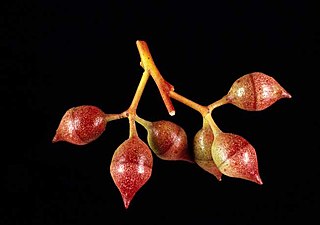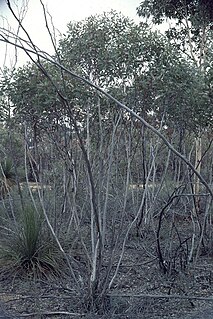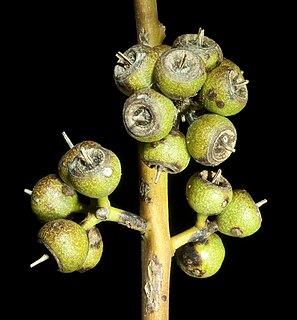Eucalyptus dolorosa, commonly known as the Mount Misery mallee or Dandaragan mallee, is a species of eucalypt that is endemic to Western Australia. It is a mallee with a short skirt of rough flaky bark at the base of the trunk, smooth pale greyish brown above, lance-shaped to curved adult leaves, flower buds in groups of seven, white flowers and cup-shaped to spherical fruit.

Eucalyptus annuliformis, commonly known as the Badgerabbie mallee, is a rare mallee that is endemic to a small area in the south-west of Western Australia. It has smooth, greyish bark, elliptic to lance-shaped leaves when mature, oval flower buds, white flowers and hemispherical fruit with a broad disc.

Eucalyptus × balanites, commonly known as Cadda Road mallee, is a tree or a mallee that is endemic to a small area of the south-west of Western Australia. It has rough, corky or flaky bark, lance-shaped adult leaves, flower buds in groups of eleven, creamy-white flowers and hemispherical to cup-shaped fruit.
Eucalyptus exigua is a species of mallee that is endemic to Western Australia. It has smooth, whitish bark, linear to narrow lance-shaped adult leaves, flower buds in groups of between seven and eleven, white flowers and short barrel-shaped to conical fruit.

Eucalyptus exilis, commonly known as Boyagin mallee, is a species of mallee that is endemic to Western Australia. It has thin stems with smooth bark, lance-shaped adult leaves, flower buds in groups of eleven, white flowers and barrel-shaped to shortened spherical fruit.

Eucalyptus insularis, commonly known as Twin Peak Island mallee, or North Twin Peak Island mallee, is a species of mallee that is endemic to a small area of southern Western Australia. It has mostly smooth bark, dull green, linear adult leaves, flower buds in group of between nine and twenty or more, white flowers and barrel-shaped fruit.
Eucalyptus kumarlensis is a species of tree that is endemic to a restricted area of Western Australia. It has smooth bark, linear to narrow, curved adult leaves, flower buds in groups of seven, nine or eleven, creamy white flowers and cup-shaped, conical or hemispherical fruit.

Eucalyptus latens, commonly known as narrow-leaved red mallee, is a species of mallee that is endemic to the south-west of Western Australia. It has smooth grey and coppery bark, linear to narrow lance-shaped adult leaves, flower buds in groups of seven to eleven or more, creamy white flowers and small barrel-shaped to shortened spherical fruit.

Eucalyptus lateritica, commonly known as laterite mallee, is a species of mallee that is endemic to a small area in the south-west of Western Australia. It has rough bark on the lower half of the trunk, smooth grey bark above, lance-shaped adult leaves, flower buds in groups of nine or eleven, white flowers and shortened spherical fruit.
Eucalyptus leprophloia, commonly known as scaly butt mallee, is a species of mallee that is endemic to a small area in Western Australia. It has rough, fibrous bark on the base of the trunk, smooth bark above, lance-shaped adult leaves, flower buds in groups of seven to eleven, white flowers and cup-shaped to barrel-shaped fruit.
Eucalyptus litorea, commonly known as saline mallee, is a species of mallee that is endemic to a small area on the southern coast of Western Australia. It has hard, rough grey bark on the trunk, smooth grey bark above, lance-shaped adult leaves, flower buds in groups of seven, white flowers and cylindrical or barrel-shaped fruit.
Eucalyptus perangusta, commonly known as fine-leaved mallee, is a species of mallee that is endemic to a small area on the south coast of Western Australia. It has smooth bark, glossy green, linear leaves, flower buds in groups of seven or nine, creamy white flowers and short, barrel-shaped fruit.

Eucalyptus petrensis, commonly known as limestone mallee, straggly mallee or koodjat, is a species of straggly mallee that is endemic to Western Australia. It has mostly smooth bark, lance-shaped adult leaves, flower buds in groups of between seven and thirteen, creamy white flowers and more or less spherical fruit.
Eucalyptus semota, commonly known as marymia mallee, is a species of mallee or small tree that is endemic to a small area in central Western Australia. It has rough, flaky to fibrous bark on the trunk, smooth grey or brown bark above, linear to narrow lance-shaped leaves, flower buds in groups of seven or nine, white flowers and conical to cup-shaped fruit.

Eucalyptus suberea, commonly known as Mount Lesueur mallee or cork mallee, is a species of mallee or a small tree that is endemic to a small area on the west coast of Western Australia. It has rough bark on some or all of the trunk, smooth white bark above, lance-shaped adult leaves, flower buds in groups of eleven to twenty or more, white flowers and shortened spherical fruit.
Eucalyptus cuprea, commonly known as the mallee box, is a species of mallee that is endemic to the west coast of Western Australia. It has rough, flaky bark on the base of its trunk, smooth coppery-coloured bark above, lance-shaped adult leaves, flower buds in groups of seven, creamy white flowers and conical to cup-shaped fruit.

Eucalyptus desmondensis, commonly known as Desmond mallee, is a species of slender mallee that is endemic to a small area in the south-west of Western Australia. It has smooth bark, lance-shaped adult leaves, flower buds in groups of between nine and nineteen, cream-coloured to pale yellow flowers and cup-shaped to barrel-shaped fruit.
Eucalyptus distuberosa is a species of mallet that is endemic to the south-west of Western Australia. It has smooth dark grey to tan-coloured or creamy white bark, glossy dark green, lance-shaped adult leaves, flower buds in groups of seven, white flowers and cup-shaped to conical fruit.
Eucalyptus proxima, commonly known as nodding mallee or red-flowered mallee, is a species of mallee that is endemic to a small area in the south-west of Western Australia. It has smooth greyish bark, lance-shaped adult leaves, flower buds in groups of seven, red to pink, sometimes yellowish flowers and conical to slightly bell-shaped fruit.
Eucalyptus retusa, commonly known as the Point Hood yate, is a species of mallee that is endemic to a restricted area in Western Australia. It has smooth, greyish bark, glossy green, egg-shaped to spatula-shaped adult leaves, flower buds in clusters of between thirteen and nineteen, yellowish green flowers and fruit with their bases fused together.











